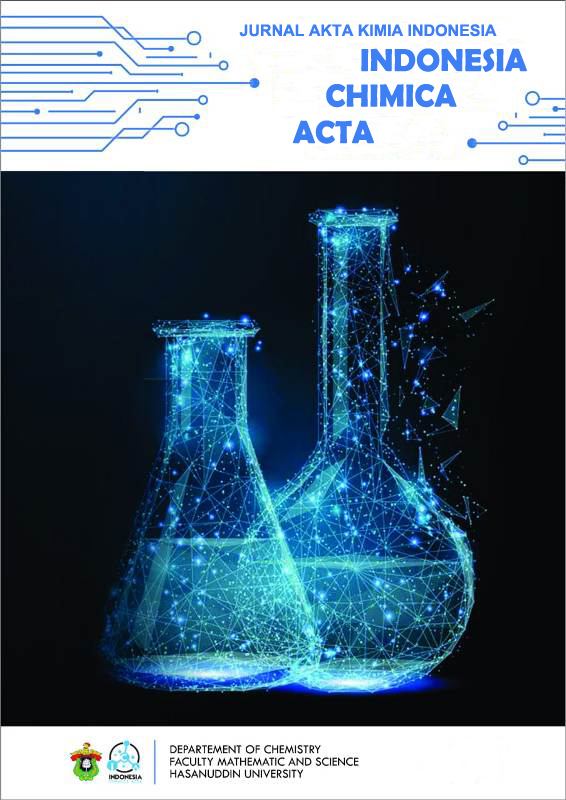SYNTHESIS OF SILVER NANOPARTICLES USING BIOREDUCTOR OF KETAPANG LEAF EXTRACT (Terminalia catappa) AND ITS POTENTIAL AS SUNSCREEN
Abstract
Synthesis of silver nanoparticles is done by the chemical reduction method using the extract of leaves of catappa (Terminalia catappa) which acts as a reducing agent with the use of AgNO3 as the precursors. The results, based on changes in color, pH, and UV-Vis absorption shows color changes from yellow to yellow-brown with a pH of 4 indicating the formation of silver nanoparticles with a wavelength range from 412,50- 404,00 nm for the storage of the first day until the seventh day with a particle size 92,48 nm based on the results of taking the measurements of PSA. Analysis of functional groups that play a role in the synthesis using FT-IR. Characterization using XRD showed that the synthesized form a cubic crystal with a crystal size of 53,48 nm. Silver nanoparticles are used as a sunscreen with a blend of hydroxy cinnamic acid compounds. Testing activities determined sunscreen with SPF values were analyzed using a UV-Vis spectrophotometer. Results of testing the activity of sunscreen alloy nanoparticles of silver and hydroxy cinnamic acid (AHNP) with a concentration of 16 μg/mL - 20 μg/ml showed the consecutive SPF value 20,97; 24,71; 26,41; 28,07 and 31,92. Sunscreen AHNP activity increases with the concentration AHNP. Based on the research results can be concluded that the combination of ultra AHNP has a protective effect (SPF ≥ 15) against UV-B rays.
Full text article
References
Abdullah, M, and Khairurijal., 2010, Characterization of Nanomaterial: Theory, Application, and Data Processing, Journal of Science and Technology, 2 (1), 1-9.
Amiruddin, M. A, and Taufikurohmah, T., 2013, Synthesis and Characterization of Gold Nanoparticles Using Bentonite Matrices as Antiaging Materials in Cosmetics, UNESA J. Chem, 2 (1), 65-71.
Ariyanta, H.A., Wahyuni, S., and Priatmoko, S., 2014, Preparation of Silver Nanoparticles with Reduction Method and Its Application as Antibacterial Cause of Infection, Indo. J. Chem. Sci, 3 (1), 1-6.
Bakir, 2011, Development of Biosynthesis of Silver Nanoparticles Using Water Decocation of Bisbul Leaf (Diospyros blancoi) for the Detection of Copper Ion (II) by Colorimetric Method, Thesis published, (online) Department of Physics FMIPA Universitas Indonesia, Jakarta.
Bevi, F., Taufikourohmah, T., and Poerwono, H., 2009, Optimization of Octile Synthesis Time p-Methoxy Sinamat (OPMS) from p-Methoxy Sinamat Acid (APMS) through Direct Esterification Reaction, Proceedings of National Seminar on Chemistry Unesa , Surabaya.
Handayani, W., 2011, Tropical Plant Utilization for Silver Nanoparticle Biosynthesis and Its Application as a Colorimetric Indicator of Heavy Metal Presence, Thesis published, (online), Biology Study Program FMIPA Universitas Indonesia, Jakarta.
Haryono, A., Sondari, D., Harmami, S.B., and Randy, M., 2008, Sitesa Silver Naoparticles and Potential Applications, Journal of Industrial Research, 2 (3), 156-163.
Jaziroh, S., 2008, Isolation and Identification of Active Compounds in Leaf N-Hexane Extract Ketapang (Terminalia catappa L.), Seminar on Final Duty of Chemistry FMIPA UNDIP Department, Chemistry Department UNDIP.
Lembang, E.Y., 2013, Synthesis of Silver Nanoparticles with Reduction Method Using Bioreductor Ketapang Leaf Extract (Terminalia catappa), Thesis published, (online), Department of Chemistry FMIPA Universitas Hasanuddin, Makassar.
Marliyana, S.D., Kusumaningsih, T., and Kristinawati, H., 2006, Determination of Total Phenol Level and Antioxidant Activity of Ketapang Seed Skin Extract (Terminalia catappa L.), Alchemy Journal, 5 (1), 39-44.
Rahayu, DS, Kusrini, D., and Fachriyah, E., 2008, Determination of Antioxidant Activity from Ketapang Leaf Extract (Terminalia catappa L.) by Methods 1.1, Diphenyl-2-picrylhydrazyl (DPPH), Chemical Laboratory Organic, chemistry majors Diponegoro University.
Restasari, A., Kusrini, D., Fachriyah, E., 2008, Isolation and Identification of the Most Active Faction of Chloroform Leaf Extract Ketapang (Terminalia catappa Linn), Thesis published, (online), Department of Chemistry Diponegoro University, Semarang.
Saputra, A.H., Haryono, A., Laksmono, J.A., and Anshari, M.H., 2011, Preparation of Colloid Nanosilver with Different Types of Reductor as Anti Bacterial, Indo. J. Materials. Sci, 12 (3), 202-208.
Suryanto, B., and Syarief, S.H., 2013, Sunscreen Activity Test of Octoy P-Methoxy Sinamat (OPMS) Gold Nanoparticles As Cosmetic Ingredients, Journal of Chemistry, 2 (3), 32-37.
Suwarda, S., and Maarif, M.S., 2011, Development of PAT-Based Nanoparticle Technology Innovation to Create a Competitive Product, Department of Industrial Technology of Agriculture, Fateta IPB Bogor.
Taufikkurohmah, T., 2005, Synthesis of p-Methoxycinamate p-Methoxycinnamate from Ethyl p-Methoxycinnamate Isolation of Kencur Rhizome (Kaempferia galanga L) as Candidate of Sunscreen, Indo. J. Chem, 5 (3), 193 – 197.
Wahyudi, T., Sugiyana, D., and Helmy, 2011, Sitesis Silver Nanoparticles and Their Activity Test against E.coli and S. Aureus Bacteria, Textile Arena, 26 (1), 1-6.
Zakir, M., Maming, Lembang, E. Y., and Lembang, M. S., 2014, Syntesis of Silver and Gold Nanoparticles through Reduction Method using Boreductor of Leaf of Ketapang (Terminalia catappa), Chemistry Department, FMIPA, Makassar.
Authors
This is an open access journal which means that all contents is freely available without charge to the user or his/her institution. Users are allowed to read, download, copy, distribute, print, search, or link to the full texts of the articles in this journal without asking prior permission from the publisher or the author.
Jurnal Akta Kimia Indonesia (Indonesia Chimica Acta) operates a CC BY-SA 4.0 © license for journal papers. Copyright remains with the author, but Jurnal Akta Kimia Indonesia (Indonesia Chimica Acta) is licensed to publish the paper, and the author agrees to make the article available with the CC BY-SA 4.0 license. Reproduction as another journal article in whole or in part would be plagiarism. Jurnal Akta Kimia Indonesia (Indonesia Chimica Acta) reserves all rights except those granted in this copyright notice.

